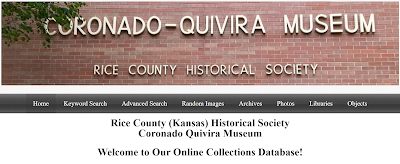Preserving Our Heritage:
Supporting Local Genealogy Societies
As soon as the competition was annihilated, Walmart no longer had to be competitive. The were able to put forth limited offerings while defining the "shopping" experience in Lyons, KS. Oh...and they most often got tax breaks to stay in town. Walmart had a system and the money backing them, even through tax payer money, allowed for them to push out the little guy.
I'm hoping the family historian and genealogists actively fight against this from happening to local genealogical societies and local repositories. We need the small town genealogical societies. Heck, we need the Kansas City genealogical societies to survive. Most have dues of $5 - $50 dollars. Societies rely on donations to heat the building, to staff the operation, to bring in speakers. Societies aren't afforded tax breaks, or taxpayer dollars. They aren't big libraries with multiple branches funded by the taxpayer. They rely on charitable donors. But, they can do wonders with a small budget. And, what they do best is preserve the local history and they can put it in perspective for you.
 Societies vs Libraries
Societies vs Libraries The locals have people who knew your people. The locals have the pics of their grandparents, often with yours identified in their family albums. They have antique stores filled with old bibles that you may identify, but time has lost the old-timers.
Even in Kansas City, where we have the the National Frontier Trails Museum, National Archives - KC, the Truman Presidential Library, Eisenhower and Hoover Presidential Libraries not far out of reach, the Midwest Genealogy Center, and the Kansas City branch of The State Historical Society, there's still a need for those who speak the language of the locals. That's when professional genealogists turn to the Clay County Historical Society & Museum. It is there where I uncovered documents for both 1) Who Do You Think You Are, Tim McGraw episode and 2) the Kearney MO episode of The Dead Files 3) plus a plethora of clients whose ancestors settled or passed through Missouri.
These specialized local repositories, like the Midwest Afro-American Genealogical Interest Coalition M.A.G.I. C: not only hold family records and vertical files in their holdings, like the other specialized local repositories, they all have someone, or can contact someone, who can be interviewed or have expertise in a field. They have community connections.
There is no "one-stop shop" for genealogy - not even the FamilySearch Library, Salt Lake City with their massive collection. Now they play fair! They support the local genealogical communities, lineage and hereditary societies, and they partner with the smaller societies because they recognize the fact that smaller societies-specialty societies and repositories - have something to offer. There's room for all. I like to say it's synergetic.
A few years back, on my last visit to Allen County, IN, there was a small local entity that needed to boost their funding, and donor contribution. Instead of smothering their membership growth, the Allen County Public Library stepped in and partnered with them in their effort. It was a great event, well attended. A great use of taxpayer dollars - keep the community viable.
What Can the Large Genealogy Libraries Do?
First they must understand, once again, diversity. The more the merrier should be the mantra when it comes to topic specialists and experienced genealogists working with the large libraries. My mother, who was a librarian and specialized in archival research, was not a historian. She was limited, as many are, from classic schoolbook sanitization of history. But, boy!, did she know her collections and the databases the library held. Thirty-two years allowed her to span actually 3 generations of high schoolers.
Mother could put her finger on the card catalog of every vertical file and finding aid like Quick Draw McGraw. She was from western Kansas after all! She may have even known local histories, but not necessarily the importance of a cultural or societal incident that may have changed the trajectory of a place, person, or community. Not once did Mother say ""Now hold on there!" and "I'll do the thin'in' around here and don't you forget it!" Instead her philosophy was "when one grows, we all grow."
Secondly, they might wish to embrace "community partnership." For the most part, I think most libraries do just that. Just like we've seen in the Walmart small town takeovers, the quality of genealogical programming can be diminished if the family genealogists has limited exposure. This is probably why the KC metro based Midwest Genealogy Center has traditionally partnered for an annual event with M.A.G.I.C, the Midwest Afro-American Genealogical Interest Coalition. This kind of partnership and specialized programming is needed and appreciated by the community.
Our family stories, though not usually shy of birthdate, marriage date, death date and census records, is not usually uncovered due to lack of research outreach. The information needed is widespread, and the local societies may hold the experts needed to guide us to our genealogical answers. Our ancestors were more than parents, offsprings, and dates; and the records needed are not always on a convenient database or in a "big" genealogical library.
Thirdly, know that limiting access to quality, and pushing specialists out of the market is the work of genealogical society bullies. They are not team players. They are like Walmart, bullies getting rid of what they consider competition vs. choices. Donors, say no to bulling!
Bullying often leads to genealogical societies losing members and membership dues. I personally think the goal is for the bully to inherit records. But, bullying results into destroying what should have been preserved - the genealogical community.
Sure the larger genealogical research libraries house books, databases and even original records, but even your favorite library should not be a "one stop shop." Our ancestors were unique.
 |
| We Partner with the Locals |
Board of Tracing Ancestors
Kathleen Brandt, President
Collaborative Article: Interns








%20(LinkedIn%20Post)%20(Instagram%20Post%20(Square))%20(Your%20Story)%20(1).jpg)














































